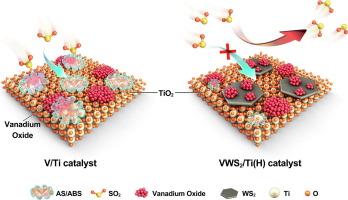Enhancing SO2 resistance in vanadium catalysts with tungsten disulfide for NH3-SCR
IF 13.3
1区 工程技术
Q1 ENGINEERING, CHEMICAL
引用次数: 0
Abstract
NOx emissions are a major environmental issue, and NH3-SCR is a key method for their control. V-based catalysts perform well at high temperatures; however, SO2-poisoning remains a critical issue for NH3-SCR catalysts under low-temperature conditions. In this study, we develop an effective strategy of loading a stable sulfide two-dimensional (2D) material, WS2, to enhance the SO2 resistance of existing commercial V/Ti catalysts. In-situ DRIFTS analysis and spent SO2-poisoning catalyst analyses are conducted to clarify the enhanced SO2 resistance mechanism. These findings demonstrate that the superior SO2 resistance can be attributed to the suppression of SO2 by WS2. Therefore, WS2 loading inhibits the SO2 adsorption and protects the NH3 species adsorption, thereby enhancing the SO2 resistance and low-temperature activity. This research can be utilized without changing the catalyst synthesis process, allowing it to be applied to current commercial catalysts, thereby underscoring its remarkable potential for industrial applications.

求助全文
约1分钟内获得全文
求助全文
来源期刊

Chemical Engineering Journal
工程技术-工程:化工
CiteScore
21.70
自引率
9.30%
发文量
6781
审稿时长
2.4 months
期刊介绍:
The Chemical Engineering Journal is an international research journal that invites contributions of original and novel fundamental research. It aims to provide an international platform for presenting original fundamental research, interpretative reviews, and discussions on new developments in chemical engineering. The journal welcomes papers that describe novel theory and its practical application, as well as those that demonstrate the transfer of techniques from other disciplines. It also welcomes reports on carefully conducted experimental work that is soundly interpreted. The main focus of the journal is on original and rigorous research results that have broad significance. The Catalysis section within the Chemical Engineering Journal focuses specifically on Experimental and Theoretical studies in the fields of heterogeneous catalysis, molecular catalysis, and biocatalysis. These studies have industrial impact on various sectors such as chemicals, energy, materials, foods, healthcare, and environmental protection.
 求助内容:
求助内容: 应助结果提醒方式:
应助结果提醒方式:


